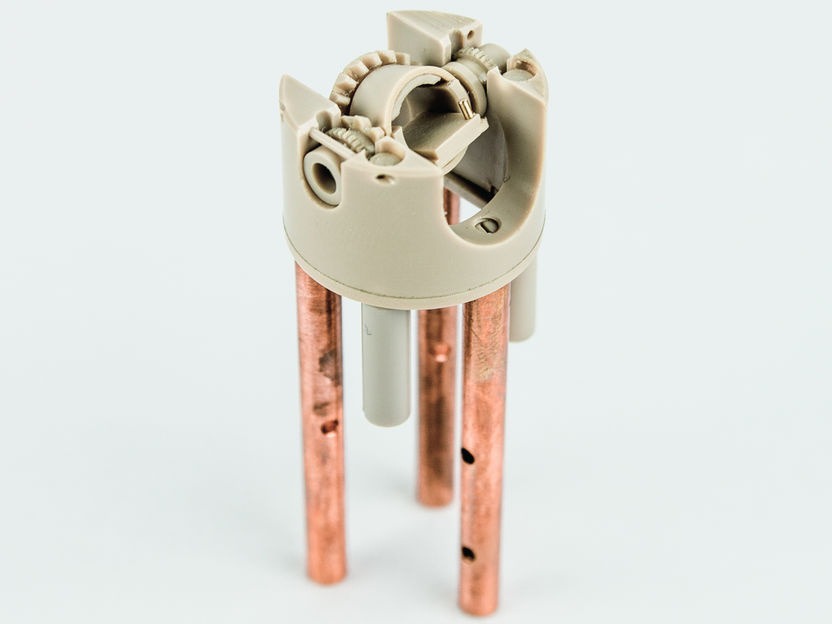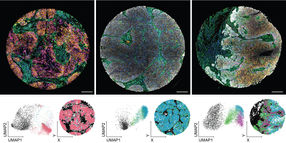Precise sample alignment under extreme conditions
Prototype already in use
The exact angular alignment of sample materials for the determination of their physical properties under extreme conditions is often difficult. Engineer Stefan Findeisen and physicist Dr. Hannes Kühne from the Helmholtz-Zentrum Dresden-Rossendorf (HZDR) have developed the "Rotax", a filigree two-axis rotator that can do just that. Now, the device is ready to conquer the market.

Rotax
HZDRI/ Peter Fritzsche
In many modern measuring setups, the samples to be examined cannot be aligned directly because they are installed in a complex environment. The scientists can then only align them correctly by remote control. Nevertheless, often a realization of all possible orientations is required – with an available sample space that is only the size of a thimble. "This is a typical situation that we encounter again and again when we want to measure physical quantities under extreme conditions, for example in very strong magnetic fields or near absolute zero temperature," says Hannes Kühne from the Dresden High Magnetic Field Laboratory (HLD) at HZDR, describing the starting point of the joint collaboration.
The new development by the two researchers from Dresden now offers a way to align sample materials in such experimental situations via two rotational axes with high precision. Commercial devices often only allow rotation around one axis, driven mechanically or piezoelectrically. In self-designed variants for rotation around two axes, for example, the complete measurement setup is rotatably mounted. "In some laboratories there are rather improvised two-axis solutions, which, however, usually have their pitfalls due to a lack of technical know-how. But here on site we have the best possibilities to practically implement ideas from research," Stefan Findeisen points out one advantage of the development work at the HZDR: "This relates specifically to the high level of engineering expertise that our Department of Research Technology has to offer."
Prototype already in use
The special feature of the new invention is the simultaneous controllability of two rotational axes that are at right angles to each other and can be moved independently of each other. This makes it possible to precisely align the investigated samples with respect to an external electromagnetic field, for example, and to do so in a very confined space. "The materials used are non-magnetic. This prevents the generation of disturbing magnetic stray fields during our measurements. All relevant components are made of the plastic polyetheretherketone, which hardly wears out and withstands even lowest temperatures undamaged," Stefan Findeisen names the outstanding properties of the chosen material. However, the Rotax can also be made of metallic material, like brass, without any problems, if a good thermal coupling of the sample at low temperatures plays a decisive role.
At HLD, there are already prototypes in two different sizes that are used for cryogenic measurements: "We have integrated one of the new two-axis rotators with an exchangeable sample carrier into a commercial cryogenic measurement system," Hannes Kühne reports and clarifies: "Nuclear magnetic resonance, electrical resistance, thermal conductivity or the magnetization of materials in high magnetic fields – we can now measure all these properties much more easily. This is reflected, for example, in more precise sample alignment and in shorter measurement times."
On the way to commercialization
The possible areas of application for the "Rotax" are manifold: they range from the determination of physical properties of new types of materials to spectroscopic applications in chemistry and imaging procedures in fundamental and application-oriented research. The automation of the measurements enables a much higher data throughput compared to a manually operated solution. By integrating planned further developments of "Rotax" into existing setups, it will also be possible to "expose" samples to X-rays or neutron beams quickly and precisely from all perspectives in a controlled manner.
The invention has already been patented. The HZDR Innovation GmbH enables the two scientists to commercialize the "Rotax" and sells the product under licence. There is demand: "According to rough estimates, there are several thousand measuring setups worldwide in which the two-axis rotator could be used by integrating it into complex measuring devices," emphasizes Dr. Stefanie Hartmann, who supports the project as innovation manager. Several international customer inquiries are currently underway; a first order was placed by a laboratory in France. An industrial partner from Thuringia has already expressed solid interest in using "Rotax" for installation in complex nuclear magnetic resonance measuring equipment. All components are manufactured by specialized companies in the Dresden area.

























































